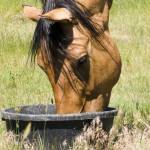When It’s Time to Change a Horse’s Feed

Feed manufacturers provide horse owners with an assortment of products to choose from, most of which are formulated to support a certain life stage or activity. When a horse’s life changes, so too should its diet.
Imagine these scenarios: a high-level Hanoverian mare sustains an injury requiring rest and the owner decides instead to put her in foal; a pasture-puff Quarter Horse comes out of retirement to serve as a youngster’s backup polo pony; a Standardbred pacer departs from the track to become an occasional driving companion; a roly-poly Arabian mare leaves the broodmare band to begin training for endurance competitions.
The horse in each scenario is transitioning from one job to another, and with each switchover energy requirements should change. The Hanoverian mare and Standardbred pacer will likely require less energy and therefore less concentrate, whereas the Quarter Horse and Arabian will, in time, require more concentrate to fuel the demands of work.
“When any significant change in workload occurs—either an acceleration or a deceleration in energy output—horse owners should closely examine the diet to make sure dietary demands mesh with nutrient delivery,” said Catherine Whitehouse, M.S., a nutrition advisor with Kentucky Equine Research (KER).
Whitehouse does not advocate rash dietary changes, as these serve only to disturb the gastrointestinal tract. All feed changes should be made little by little over the course of 10-14 days.
The Quarter Horse and the Arabian, for instance, might require no significant change in their diets for the first couple weeks of work since both will be conditioning slowly for demanding sports. While energy output will elevate during these initial conditioning periods, both horses are holding sufficient weight to fuel the minimal effort asked of them. As weeks pass and riders ask more of their mounts, they will require an upgrade in protein, vitamins, and minerals, in addition to energy, to support performance goals. At this juncture, a concentrate tailored to performance horses should be chosen.
“Owners should also take into consideration feeding strategies that have been fine-tuned for certain sports. Researchers at KER, for example, have spent considerable time studying the specialized nutritional needs of endurance horses, so this knowledge can be used to hit specific training and competition targets,” said Whitehouse.
On the flip side, the Hanoverian mare and Standardbred pacer will be coming off performance peaks, segueing into lifestyles that are more sedentary. In these instances, owners will gradually wean the horses off high-energy diets, changing instead to diets that fulfill basic nutrient requirements without all of the calories required for top performance.
“For these two horses, instead of a high-test performance feed, they will probably do well on feeds designed especially for idle horses, as both Hanoverians and Standardbreds are notoriously easy keepers,” Whitehouse advised.
Managing every horse as an individual is key, said Whitehouse, though a close look at any horse’s diet is necessary when a change in employment occurs.
Does equine nutrition have you befuddled? Don’t know where to begin? Don’t worry. Get advice from the nutrition advisors at KER today.








